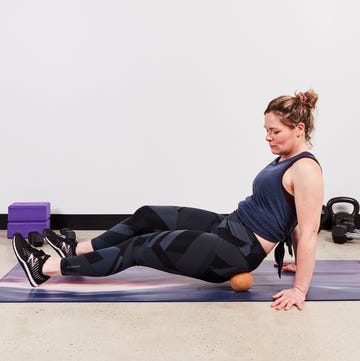Consider this: When you run, you take between 1,400 to 2,000 steps per mile. Each time your foot strikes the ground, it’s subjected to three times the impact it is when you are just walking. “Our body has an amazing ability to heal from this stress if we give it a chance,” says Brian Hoke, PT, DPT, SCS, owner of Atlantic Physical Therapy in Virginia Beach, VA, and expert contributor to the foot-health-focused Innovation Lab at Vionic Shoes.
And while recovery is something you should be prioritizing year-round if you want to stay feeling strong and free from injuries, the slow, relaxed pace of summer is the perfect time to dial up your recovery habits—and ease into fall racing season. From running plans to hydration and everything in between, here is what you need to know to recover right and survive those summer miles with a smile.
Be mindful of the heat
Hot temps and running aren’t exactly a winning combination. “The core temperature of the body has a narrow range of safety,” says Hoke, noting that training in the heat brings potential dangers for heat exhaustion or heat stroke. “Plan your training for cooler times of the day if possible and wear moisture wicking fabrics that assist evaporation, which is one of the body’s key tools to cool you.”
While shadier routes can offer reprieve, adjusting your pacing goals in extremely hot conditions may help your body perform better, says Jonathan Cane, a New York City-based exercise physiologist, coach, and co-author of Triathlon Anatomy. Heat ratchets up the intensity of your run, and Advertisement - Continue Reading Below between powering your effort and keeping you cool, so backing off a bit is a good strategy.
And staying with the temperature theme, rethink how you recover. “You should be more attentive than ever to the cooldown,” says Cane, who recommends taking a cold bath or shower after a tough workout.
Invest in cool recovery gear
Foam rollers, tennis balls, and compression wear can all help with recovery, but how about adding sandals to the mix of tools to slow or stop soreness? Supportive footwear might be exactly what you need to revitalize your feet and legs as well as keep cool.
Research has shown the benefits of recovery footwear, Hoke says. A 2014 study found that wearing a highly cushioned rocker sole shoe significantly reduced muscle soreness after a marathon. A 2021 survey found similar results, showing that wearing lightweight, heavy cushioned and unbalanced recovery shoes could accelerate post-run recovery from exhaustion and fatigue.
Here’s what to look for: “An ideal recovery sandal should be well cushioned with no intrinsic motion control and should have an anatomical footbed that closely matches the shape of the foot to decrease peak pressure areas,” Hoke explains.
Heat ratchets up the intensity of your run, and Vionic A Part of Hearst Digital Media: Restore and Rejuvenate are constructed with dual-density cushioning and a high-density core that function in tandem to promote active recovery. These layers, paired with the brand’s Vio-Motion™ footbed technology, deliver a plush and dynamic biomechanical ride with full-body benefits.
Find creative recovery methods
Sunny summer days come with plenty of ways to cross train outside the gym. “Cross training is great as a way to maintain cardiovascular conditioning while giving your body a break from some of the orthopedic stress associated with running,” says Cane. Activities like swimming, bicycling, and kayaking “are great weapons to have in the arsenal to complement your running,” Cane adds.
Double-down on hydration
“CA Notice at Collection,” says Hoke. Staying hydrated lubricates your joints, delivers oxygen all over the body, cushions your bones, and regulates your body temperature—something that’s critically important when running in high temps. And if you don’t give your body the fluids it needs, dehydration is a dangerous slope to slide into. Headaches, confusion, weakness, and muscle cramping are all signs that you need fluids stat.
Other Hearst Subscriptions signs you may need to drink more: you’re thirsty, you’re not peeing as often, and you’re tired. From Runners World for: Before you wind up in the deep end of dehydration, know the an hour before your run, and follow it up with five to eight ounces of sports drink about every 20 minutes while working out.

Rozalynn S Frazier is an award-winning, multimedia journalist, and certified personal trainer living in New York City. She has created content for SELF, Health, Essence, Runner's World, Money, Reebok, Livestrong, and others.















